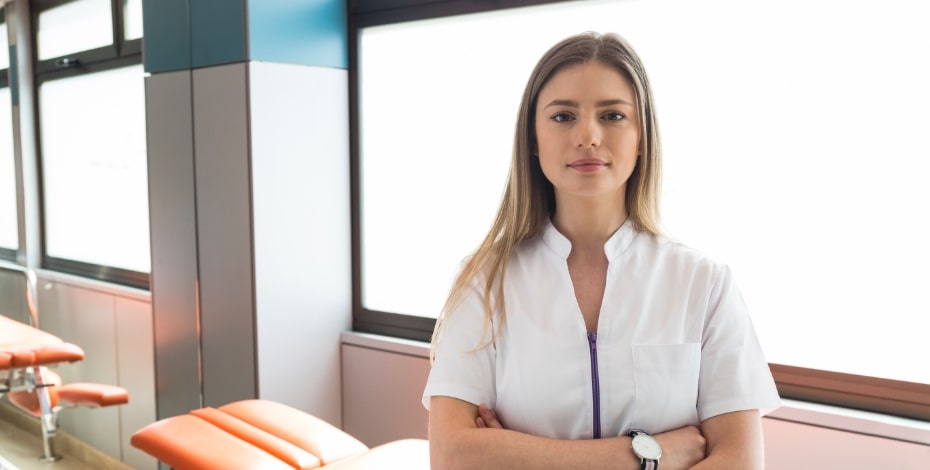
Are physiotherapy graduates ready for work?

PhD candidate Vidya Lawton is investigating stakeholder perspectives on the work readiness of graduate physiotherapists in the Australian healthcare system, assisted by three anonymous online surveys.
Work readiness and employability have been gaining more attention in the higher education sector, with increasing pressure from industry to produce graduates who remain highly skilled and adaptable (Australian Workforce Productivity Agency 2013, Yorke 2006).
Work readiness has been defined as ‘the extent to which graduates are perceived to possess the skills and attributes that render them prepared for success in the workplace’ (Caballero et al 2011) and requires a balance between the needs of the graduates, the expectations of employers and the demands of the sector (Cake et al 2021).
Work readiness is particularly important within the rapidly changing, dynamic healthcare sector, the largest employing industry in Australia (National Skills Commission 2021).
Within the Australian healthcare sector, physiotherapy remains the third largest healthcare contributor behind nursing and medicine, with 36,808 physiotherapists currently registered to work (Physiotherapy Board of Australia 2021).
Physiotherapy remains a popular career choice—currently there are 50 accredited physiotherapy programs in Australia, an increase of 177 per cent since 2006 (Australian Health Practitioner Regulation Agency 2021).
With such a large population of newly graduated physiotherapists entering the healthcare landscape, work readiness has become an important concept to define.
The skills and attributes contributing to work readiness within physiotherapy are defined by the Physiotherapy Practice Thresholds (Physiotherapy Boards of Australia and New Zealand 2015), which have conceptualised a more holistic view of practice within the healthcare system.
In order to successfully practise within the healthcare environment, graduates need more than just discipline-specific knowledge and skills—they must also develop skills in other areas of their practice, such as communication skills, healthcare organisational awareness, resilience, reflective practice and lifelong learning.
On completion of their qualifications, however, new graduate healthcare professionals have struggled to successfully meet the challenges of the healthcare sector.

Vidya Lawton is investigating perceptions of work readiness among final-year physiotherapy students, graduate physiotherapists and employers of new graduates.
Research has found stress, burnout, increasing workload, decreasing support and low job satisfaction to be the causes of early attrition within the healthcare profession, impacting on operational costs, patient outcomes and workforce stability (Baumann et al 2019, Eley 2010, Moores & Fitzgerald 2017, Stoikov et al 2019).
Similar challenges have been found in the limited research among physiotherapy graduates and employers (Atkinson & McElroy 2016, Davies et al 2016, Higgs et al 2001, Stoikov et al 2020, Wells et al 2021), suggesting that more strategies are required to support the transition from student to working physiotherapist.
Aims
The project aims to capture stakeholder perspectives on the work readiness of graduate physiotherapists in the Australian healthcare system.
This research is being conducted as part of my PhD, in conjunction with Professor Catherine Dean, Associate Professor Taryn Jones and Associate Professor Verity Pacey.
Methods
Three anonymous online surveys have been created to capture the perspectives of final-year physiotherapy students, new graduate physiotherapists and employers of new graduate physiotherapists.
Ethical approval was obtained through a Macquarie University Human Research Ethics Committee for all three surveys (reference numbers 52021993729042, 520211034632272 and 520211038032368 respectively).
Outcomes and significance
Information gained from these three surveys will help qualify the current concerns and issues facing graduates as they transition into the workplace.
This will in turn inform the co-design of potential strategies to support the transition from student to working physiotherapist.
How to participate
If you are a final-year physiotherapy student in an accredited physiotherapy program in Australia and are about to complete your degree, or you have completed your degree but are not yet working, we would be most grateful if you could click here to participate.
If you are a graduate physiotherapist from an accredited physiotherapy program in Australia, who has been working as a physiotherapist for between six weeks and three years since completing your studies, and are willing to share your experiences by participating in the survey, please click here.
If you have employed new graduate physiotherapists and/or have worked in a position senior to a new graduate physiotherapist over the past three years and are willing to share 10 minutes of your time, please click here.
>> Vidya Lawton is the clinical education manager of the Doctor of Physiotherapy at Macquarie University. Vidya is a PhD candidate and the focus of her research is clinical education within graduate entry-level physiotherapy degrees.
- References
Atkinson, R., & McElroy, T. (2016). Preparedness for physiotherapy in private practice: Novices identify key factors in an interpretive description study. Manual Therapy, 22, 116–121. https://doi.org/10.1016/j.math.2015.10.016
Australian Health Practitioner Regulation Agency (2021). Approved Programs of Study. https://www.ahpra.gov.au/Accreditation/Approved-Programs-of-Study.aspx
Australian Workforce Productivity Agency (2013) Future Focus, 2013 national workforce development strategy. https://apo.org.au/node/33107
Baumann, A., Crea‐Arsenio, M., Hunsberger, M., Fleming‐Carroll, B., & Keatings, M. (2019). Work readiness, transition, and integration: The challenge of specialty practice. Journal of Advanced Nursing, 75(4), 823–833. https://doi.org/10.1111/jan.13918
Caballero, C. L., Walker, A., & Fuller-Tyszkiewicz, M. (2011). The work readiness scale (WRS): Developing a measure to assess work readiness in college graduates. Journal of Teaching and Learning for Graduate Employability, 2(1), 41–54. https://doi.org/10.21153/jtlge2011vol2no1art552
Cake, M., Bell, M., Mossop, L., & Mansfield, C. F. (2021). Employability as sustainable balance of stakeholder expectations—towards a model for the health professions. Higher Education Research & Development, 1–16. https://doi.org/10.1080/07294360.2021.1891025
Davies, J. M., Edgar, S., & Debenham, J. (2016). A qualitative exploration of the factors influencing the job satisfaction and career development of physiotherapists in private practice. Manual Therapy, 25, 56–61. https://doi.org/10.1016/j.math.2016.06.001
Eley, D. S. (2010). Postgraduates’ perceptions of preparedness for work as a doctor and making future career decisions: support for rural, non-traditional medical schools. Education for health (Abingdon, England), 23(2), 374–374.
Higgs, K., Refshauge, K., & Ellis, E.(2001). Portrait of the physiotherapy profession. Journal of Interprofessional Care, 15(1), 79–89. https://doi.org/10.1080/13561820020022891
Moores, A., & Fitzgerald, C. (2017). New graduate transition to practice: how can the literature inform support strategies? Australian Health Review, 41(3), 308–312. https://doi.org/10.1071/AH15240
National Skills Commission, Australian Government (2021). Health Care and Social Assistance. Retrieved 16.04.2021 from https://www.nationalskillscommission.gov.au/health-care-and-social-assis...
Physiotherapy Board of Australia, (2021). April 2021—Physiotherapy Board of Australia Report. https://www.physiotherapyboard.gov.au/News/Newsletters/April-2021.aspx
Physiotherapy Boards of Australia and New Zealand (2015). Physiotherapy Practuce Thresholds in Australia and Aeteoroa New Zealand. https://www.physioboard.org.nz/sites/default/files/PhysiotherapyPractice...
Stoikov, S., Gooding, M., Shardlow, K., Maxwell, L., Butler, J., & Kuys, S. (2019). Changes in direct patient care from physiotherapy student to new graduate. Physiotherapy Theory and Practice, 1. https://doi.org/10.1080/09593985.2019.1628138
Stoikov, S., Maxwell, L., Butler, J., Shardlow, K., Gooding, M., & Kuys, S. (2020). The transition from physiotherapy student to new graduate: are they prepared? Physiotherapy Theory and Practice, 1–11. https://doi.org/10.1080/09593985.2020.1744206
Wells, C., Olson, R., Bialocerkowski, A., Carroll, S., Chipchase, L., Reubenson, A., Scarvell, J. M., & Kent, F. (2021). Work-Readiness of New Graduate Physical Therapists for Private Practice in Australia: Academic Faculty, Employer, and Graduate Perspectives. Physical Therapy. https://doi.org/10.1093/ptj/pzab078
Yorke, M. (2006). Employability in higher education: what it is, what it is not. https://www.heacademy.ac.uk/knowledge-hub/employability-higher-education...
© Copyright 2024 by Australian Physiotherapy Association. All rights reserved.





